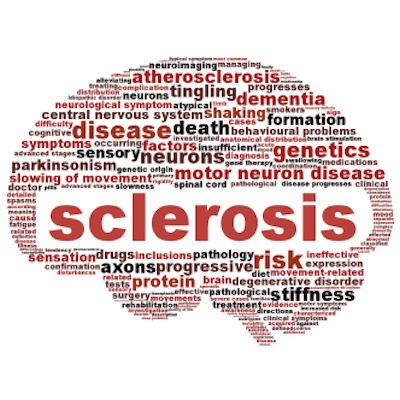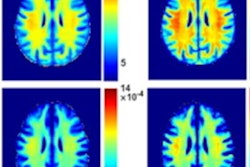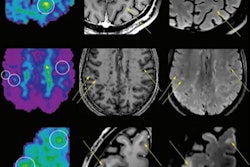
Three basic MRI biomarkers can help clinicians determine the current level of disease severity and disability in patients with multiple sclerosis (MS), according to a study published April 3 in PLOS One.
Japanese researchers identified gray- and white-matter atrophy and the number of T1-hypointense areas in the brain as significant indicators of the condition, while the size and number of fluid-attenuated inversion-recovery (FLAIR)-hyperintense lesions correlated with previous relapses by patients with MS.
"Although the clinical importance of each of these imaging parameters has been separately shown, which of the parameters should be the most clinically important, and what exactly each of the parameters clinically indicates in the management of patients with MS has not been fully elucidated," wrote the authors, led by Dr. Tetsuya Akaishi, PhD, at Tohoku University Graduate School of Medicine in Sendai. "In this study, we demonstrated the importance of the amount of T1-hypointense areas, together with the brain atrophy, as a parameter of concurrent neurological disability."
MS origins
Patients with multiple sclerosis experience a number of conditions that exacerbate the disease. The abnormalities can be seen on MRI with the help of a T2-FLAIR sequence that can highlight lesions in the brain and spinal cord that damage myelin, the protective sheath that surrounds and protects these cells.
T2-FLAIR also can find T1-hypointense lesions, also known as T1 black holes, which are common with severe central nervous system damage and MS. Additionally, MS patients show signs of accelerated brain atrophy in the brain's gray matter and white matter, which adversely affects motor function.
While T2-FLAIR hyperintense lesions are considered one primary diagnostic imaging parameter for MS, its role as a "surrogate parameter to reflect neurological disability or prognosis is uncertain," Akaishi and colleagues noted. It also remains unclear whether gray and/or white matter atrophy or T1-hypointense lesions are better indicators for neurological disability.
"Progressive brain atrophy, development of T1-hypointense areas, and T2-FLAIR-hyperintense lesion formation in multiple sclerosis are popular volumetric data that are often utilized as clinical outcomes," the authors added. "However, the exact clinical interpretation of these volumetric data has not yet been fully established."
Patients profiles
To help provide some of that information, the researchers enrolled 42 consecutive patients with MS (mean age at disease onset, 26.7 ± 8.3 years ) who each underwent one 3-tesla whole-body MRI scan (Ingenia CX or Achieva, Philips Healthcare). The protocol included fat-saturated 3D T2-FLAIR and a 3D T1-weighted fast field echo (FSE) sequences to determine age-adjusted gray- and white-matter volume, T2-FLAIR-hyperintense lesion volume, and T1-hypointense areas. At the time of the brain scans, subjects had MS for a mean of 12.4 (±7.5) years and were followed up for more than three years.
Akaishi and colleagues also gathered the patients' demographic information, their expanded disability status scale (EDSS), MS severity score (MSSS), and the number of previous clinical relapses. EDSS assesses the severity of MS on a scale of 0 to 10 in order to monitor a patient's status over time. A rating of 1 to 4.5 indicates a person with MS who can walk unassisted, while 5 to 9.5 means the patient has difficulty walking, according to the Multiple Sclerosis Trust. A patient's MSSS score is based on their EDSS scale and disease duration. This cohort had a median EDSS of 2 and a median MSSS of 3.37.
MS indicators
As the researchers compared each volumetric and clinical parameter on MR images, they found that the number of T1-hypointensity areas and the volume of gray- and white-matter atrophy significantly correlated with a patient's EDSS score. In other words, the trio were prime indicators of an MS patient's current condition.
| Significant indicators of MS disease severity | |||
| T1-hypointensity | Gray-matter atrophy | White-matter atrophy | |
| EDSS | 0.51 | 0.40 | 0.49 |
| p value* | < 0.001 | < 0.01 | < 0.001 |
*All p values are statistically significant
When the researchers combined T2-FLAIR-hyperintense lesion volume and T1-hypointensity areas, the two variables significantly reflected a patient's MSSS score (rho = 0.55; p < 0.001).
"Another notable finding of this study was that a simple T1-[hypointensity] count could efficiently reflect the clinical severity and disease activity," the authors added. "Because T1-count can be manually counted without specific volumetric software, this simple information would be quite useful in routine clinical practice to estimate the ongoing disease activity in each MS patient."
The cross-variable analyses also discovered that the number and volume of T2 FLAIR-hyperintense lesions were associated with previous disease relapses the subjects experienced, but they did not correlate with the degree of MS or disease activity. All the findings were consistent regardless of spinal cord lesions.
Given the results, Akaishi and colleagues were quite encouraged that they "demonstrated the importance of the amount of T1-hypointense areas, together with the brain atrophy, as a parameter of concurrent neurological disability," they concluded. Additional research, however, is needed to "determine the importance of regular follow-ups of the number and volumes of T1-hypointense areas, along with T2-FLAIR-hyperintense lesion volume, to evaluate treatment efficacy or to estimate the eventual neurological prognosis in patients with MS."


.fFmgij6Hin.png?auto=compress%2Cformat&fit=crop&h=100&q=70&w=100)





.fFmgij6Hin.png?auto=compress%2Cformat&fit=crop&h=167&q=70&w=250)











